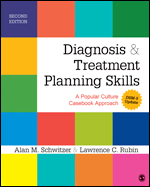Diagnosis and Treatment Planning Skills
A Popular Culture Casebook Approach (DSM-5 Update)
Alan M. Schwitzer - Old Dominion University, Norfolk, USA
Lawrence C. Rubin - St. Thomas University, USA
The Second Edition of Alan M. Schwitzer and Lawrence C. Rubin’s Diagnosis and Treatment Planning Skills: A Popular Culture Casebook Approach comprehensively addresses the clinical thinking skills required in professional counseling settings through the innovative use of case examples drawn from popular culture. Fully revised to include DSM-5, the text begins with discussion of diagnosis, case conceptualization, and treatment planning, covering the interplay of individual clinical tools and their application in contemporary practice. Ten DSM-5 updated case illustrations follow, creating a streamlined new edition that engages students in a start-to-finish application of clinical tools.
Available formats
See what’s new to this edition by selecting the Features tab on this page. Should you need additional information or have questions regarding the HEOA information provided for this title, including what is new to this edition, please email sageheoa@sagepub.com. Please include your name, contact information, and the name of the title for which you would like more information. For information on the HEOA, please go to http://ed.gov/policy/highered/leg/hea08/index.html.
For assistance with your order: Please email us at textsales@sagepub.com or connect with your SAGE representative.
SAGE
2455 Teller Road
Thousand Oaks, CA 91320
www.sagepub.com
This site includes an additional 20 cases from the first edition, now updated for DSM-5.
NEW AND KEY FEATURES:
- Early chapters present in-depth discussion of diagnosis, the DSM-5, case conceptualization, and treatment planning.
- Ten case illustrations, now fully updated for DSM-5, are drawn from relevant pop culture characters to provide common ground for students as they develop their clinical skills.
- Each case offers a start-to-finish illustration of the diagnosis and treatment planning process, offering students an extensive “caseload” of their own.
- Diversity within the contexts of age, gender, nationality, socio-economic status, ethnicity, and culture is represented in the cases.
- “Professional Perspectives” and “Clinical Spotlights” provide additional examples, ideas, and insights from real-life clinical experiences.
- An additional 20 cases from the first edition, now updated for DSM-5, are available to the reader online.

